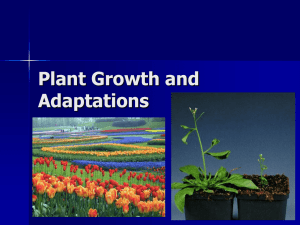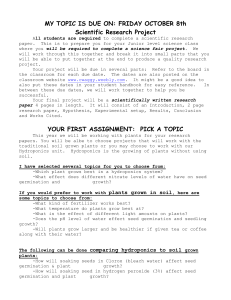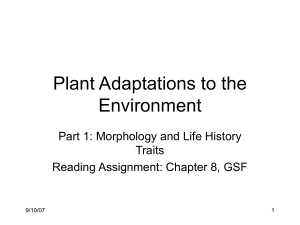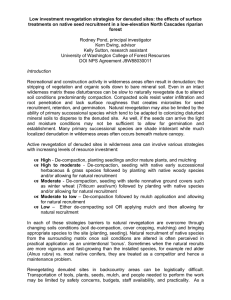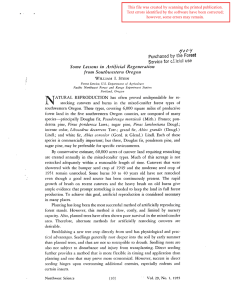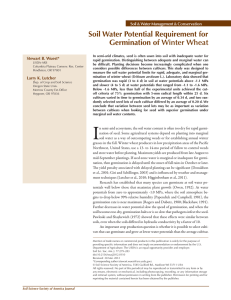Plant Growth and Adaptations
advertisement
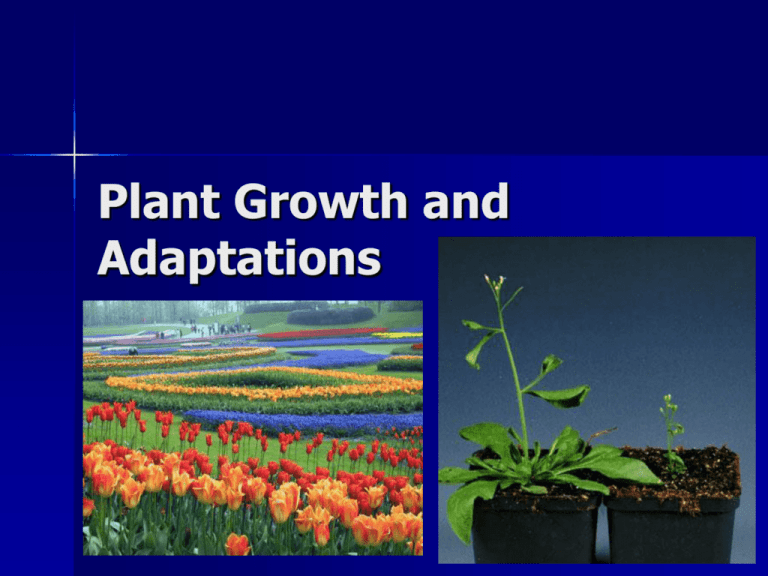
Plant Growth and Adaptations Chandelier Tree - California Venus Fly Trap Soil and Minerals Soil contains a number of important nutrients needed by plants. Plants absorb minerals from the soil (in water) and distribute them to all cells. Soil Layers Plants adapt to different soil types. Plants grow in the top 3 layers: O = Humus A = Topsoil B = Subsoil C = Bedrock Legumes use “Nitrogen Fixation” to absorb Nitrogen directly Minerals - The Big Three In organic Fertilizers contain: -Nitrogen (N): Promotes green growth -Phosphorus (P): roots & flowers -Potassium (K): hardiness (overwinter) The 3 numbers represent the % of the three elements in order (N, P, K) Organic Vs. Inorganic Read Page 560 Write down a definition for: -Organic Fertilizer -Inorganic Fertilizer What is the advantage of using organic fertilizers? Release Nutrients slowly; nutrients won’t get washed away easily Which Fertilizer? With a partner complete the “Discovering Biology” activity on P.560 High Veggie Yield = 12-12-12 Winter lawn = 10-4-14 Lush green lawn = 25-3-5 New lawn from seed =20-27-5 Many Flowers = 10-20-10 It all starts with a seed… Most seeds go through a period of dormancy. When conditions are favourable, the seed will germinate. Geotropism Lab Setup Setup your petri dishes with radish seeds and watch them grow!! Seed Anatomy Seed coat: -Protection from damage and drying out. Cotyledon: -stored food for growing embryo during germination. Embryo: -Baby plant that remains dormant until germination. Radicle: The primary shoot out of the seed Germination: -The process that occurs between the time the seed coat cracks open until the first leaves appear. Germination 1. Seed ends its dormancy 2. The embryo releases the hormone Gibberellin (this starts the release of digestive enzymes which convert the stored starches in cotyledon into sugars for anaerobic cellular respiration) Germination 3. The seed absorbs water, swells, seed coat cracks 4. Oxygen can now be absorbed so aerobic respiration begins. 5. Rapid growth (mitosis) of radicle occurs. *Sketch diagram 17.12 on Page 563 Root Growth – The Zones Root Cap: Strong tip for protection Zone of Growth (Apical Meristem): Initial Growth/Division Zone of Elongation: Cells lengthen and elongate Zone of Maturation: Cells mature and specialize Roots – Up close! Complete the microviewer activity! Adaptations Using your text (P. 563), identify two plant adaptations to the following environments: -Desert -Cold Climate -Wet -Fire -Nutrient-Poor Soil -Shade Desert Waxy cuticle (cactus) Small or no leaves Extensive Root systems Quick Germination and Rapid Growth Hardy seeds Wet Environments Floating leaves Specialized roots Hollow stems for oxygen transport Stoma on top of leaf Fire Adaptations Seeds need to be singed to germinate Fireweed – quick growth after fire Ash environment ideal for young seedlings Primary Succession Succession=develop ment of plant life No plant life there previously Takes place over a long period of time Eg. Volcanic islands Secondary Succession Gradual development of plant community in an area with soil already Area has been disturbed Eg.Wildfire Fireweed Very aggressive plant Colonizes disturbed sites well; even after oil spills Will grow from temperate to arctic zones Fireweed! Cold Climates Flowers act as solar collectors Leafs drop off Dormant period Nutrient-Poor Soil Carnivorous plants – capture insects for nutrition Parasitic plants (vines) Mistletoe! Shade Adaptations Smaller plants bloom early (before maples!) Rapid growth Plant Hormones Complete the worksheet using P. 568 as a reference Farmer for a day! a) b) Pretend you are a commercial farmer and want to maximize your long term profit. Each group will pick a plant hormone and explain (in a creative way!): The benefits of using it on your crops The risks of using it on your crops
